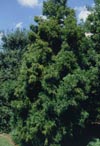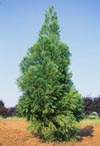Home >
Cryptomeria japonica, Japanese Cedar
Provide an acid soil and protection from the drying effect of winter winds. Foliage on plants in a windy situation in winter often turn brown, but only in the northern half of its hardiness range. Locate the tree so air circulation is good, particularly during summer to help prevent leaf blight. Trees perform best with afternoon shade in southern part of its range - morning sun helps keep foliage dry which theoretically reduces the incidence of foliage disease. Foliage disease can be quite devastating, especially in a location without good air circulation. Many cultivars are available varying in growth habit and ability to hold green foliage color in the winter. There are so many cultivars one has to wonder why we need more. I have seen plants in zone 8B-9A perform fairly well.
Cryptomeria is tolerant of compacted soil and grows nicely in urban landscapes such as parking lots. Some irrigation on established plants will help them remain looking good in these stressful environments. It makes a wonderful accent, screen, or border tree. It may grow too large for most residential landscapes, but it does so slowly. They have been used as street trees planted 10 feet back from the street in residential areas. One reference says pollen causes severe allergy problems, especially when many trees are planted in the same location. Another reference says pollen causes no allergies.



